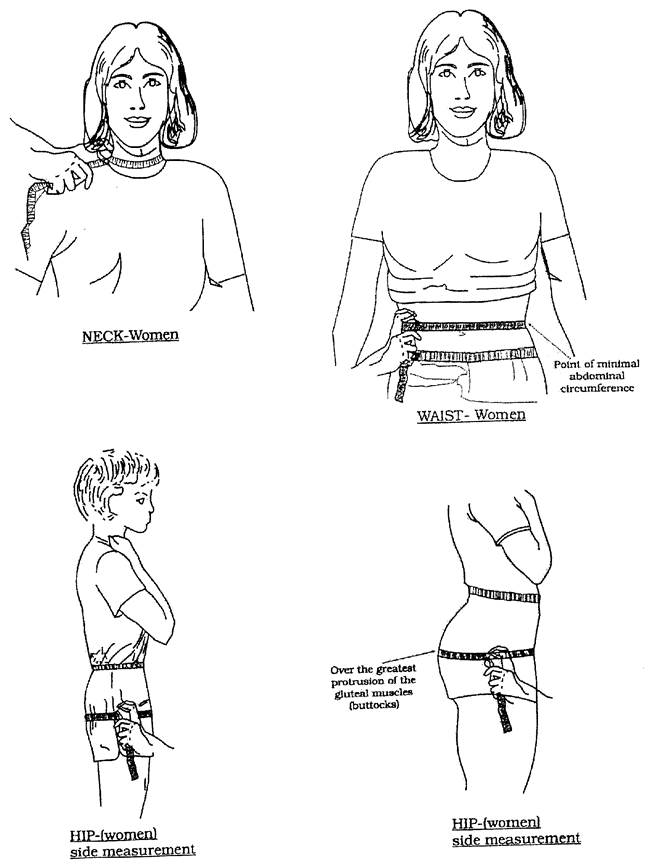Chapter 3 Proper Weight Control
3–1. Policy
a. Commanders and supervisors will monitor all members of their command (officers, warrant officers, and enlisted personnel) to ensure that they maintain proper weight, body composition, and personal appearance. At minimum, personnel will be weighed when they take the APFT or at least every 6 months. Soldiers may be weighed immediately before or after they take the APFT. Personnel exceeding the screening table weight (table 3–1) or identified by the commander or supervisor for a special evaluation will have a determination made of percent body fat. Identification and counseling of overweight personnel are required.
Table 3–1 Weight for height table (screening table weight)

Notes:
Male and female Soldiers who fall below the minimum weights shown in table 3–1 will be referred for immediate medical evaluation.
1 Height will be measured in stocking feet (without shoes), standing on a flat surface with the chin parallel to the floor. The body will be straight but not rigid, similar to the position of attention. The measurement will be rounded to the nearest inch with the following guidelines: If the height fraction is less than 1/2 inch, round down to the nearest whole number in inches; if the height fraction is 1/2 inch or greater, round up to the next highest whole number in inches.
2 Weight will be measured and recorded to the nearest pound within the following guidelines: If the weight fraction is less than 1/2 pound, round down to the nearest pound; if the weight fraction is 1/2 pound or greater, round up to the next highest pound.
3 All measurements will be in a standard PT uniform (gym shorts and T-shirt, without shoes).
4 If the circumstances preclude weighing Soldiers during the APFT, they will be weighed within 30 days of the APFT.
5 Add 6 pounds per inch for males over 80 inches and 5 pounds for females for each inch over 80 inches.
b. Commanders and supervisors will provide educational and other motivational programs to encourage personnel to attain and maintain proper weight (body fat) standards. Such programs will include—
(1) Nutrition education sessions conducted by qualified health care personnel. These sessions are required for all Soldiers enrolled in a weight control program.
(2) Exercise programs, even though minimum APFT standards are achieved.
c. Maximum allowable percent body fat standards are shown in table 3–2. However, all personnel are encouraged to achieve the more stringent Department of Defense goal, which is 18 percent body fat for males and 26 percent body fat for females.
Table 3–2 Maximum allowable percent body fat standards
Age Group: 17–20 Male (% body fat): 20% Female (% body fat): 30%
Age Group: 21–27 Male (% body fat): 22% Female (% body fat): 32%
Age Group: 28–39 Male (% body fat): 24% Female (% body fat): 34%
Table 3–2 Maximum allowable percent body fat standards—Continued
Age Group: 40 & Older Male (% body fat): 26% Female (% body fat): 36%
d. Personnel who are overweight, including Soldiers who become pregnant while on the weight control program—
(1) Are nonpromotable (to the extent such nonpromotion is permitted by law).
(2) Will not be assigned to command, command sergeant major or first sergeant positions.
(3) Are not authorized to attend professional military schools. All Soldiers scheduled for attendance at professional military schools will be screened prior to departing their home station/losing command. Heights and weights will be recorded on their TDY orders (DD Form 1610 (Request and Authorization for TDY Travel of DOD Personnel), block 16) or on their PCS packets. Soldiers exceeding the screening table weight in table 3–1 will not be allowed to depart their command until the commander has determined they meet body fat composition standards.
(4) Arriving at any DA board select school or those who PCS to a professional military school who do not meet body composition standards will be processed for disenrollment and, if applicable, removal from the DA board select list, as follows:
(a) The Soldier will be notified in writing of the proposed action, the basis for the proposed action, and the consequences of denied enrollment and removal from the selection list.
(b) The Soldier will be provided an opportunity to submit matters in rebuttal in a reasonable period of time (not to exceed 5 working days) from receipt of notification.
(c) The approval authority is the Soldier’s general court-martial convening authority, who will take prompt action consistent with the best interests of the Army after review of all matters submitted. The approval authority must approve enrollment denial and removal from the DA board select list if he finds that, in light of all the facts and circumstances, the Soldier’s failure to meet body fat standards was the result of a lack of self-discipline expected of a Soldier of similar rank and experience.
(5) Arriving at professional military schools (other than DA board select or PCS schools) who do not meet body fat composition standards will be denied enrollment without further process and reassigned in accordance with paragraph 3–1_d_(6).
e. When enrollment has been denied in accordance with paragraph 3–1_d_(4) or (5), the following policy applies:
(1) For Active Army Soldiers denied enrollment when on—
(a) TDY and return. Soldiers will be immediately returned to home station.
(b) TDY en route. Soldiers will be attached to the installation pending clarification of assignment instructions for follow on assignment. The school commandant will notify the Human Resources Command (HRC) of the Soldier’s ineligibility for schooling and request clarification of assignment instructions.
(c) PCS. Policy in paragraph 3–1_d_(4) will be followed. If enrollment is denied, Soldiers will be reported immediately as available for assignment and attached to the installation pending assignment instructions from HRC–Alexandria.
(2) For the Active Army National Guard Soldier denied enrollment when on—
(a) TDY and return. All ARNGUS Soldiers in a Title 32 status will return to home station. For M-Day and Title 32 AGR Soldiers, the school commandant will forward the memorandum to the Adjutant General of the State concerned. The school commandant will forward the memorandum to CNGB, ATTN: NGB–ARZ.
(b) TDY en route. Title 32 AGR Soldiers will be returned immediately to home station. The memorandum from the school commandant will be forwarded to the Adjutant General of the State concerned. ARNG Title 10 Soldiers will be sent to their next permanent duty station. The memorandum will be forwarded to CNGB, ATTN: NGB–ARZ.
(c) PCS. Policy in paragraph 3–1_d_(4) will be followed. Title 32 Soldiers will be returned immediately to home station. ARNG Title 10 personnel will be attached to the office of the senior ARNG advisor at the installation pending receipt of permanent assignment instructions from NGB–ARP–CT.
(3) U.S. Army Reserve Soldiers denied enrollment when on—
(a) TDY and return. All Soldiers will return to home station. For USAR Title 10 AGR, the memorandum is forwarded to the Commander, HRC–St. Louis. For non-AGR Soldiers, the memorandum is forwarded to the first general officer in the Soldier’s chain of command.
(b) TDY en route. USAR Title 10 AGR Soldiers will be sent to their permanent duty station. The memorandum will be forwarded to Commander, HRC–St. Louis. The school commandant will immediately notify the gaining installation.
(c) PCS. Policy in paragraph 3–1_d_(4) is followed. The school commandant will immediately report the Soldier to the Commander, HRC–St. Louis as available for assignment. Pending clarification of further instructions, attach the Soldier to the office of the senior USAR advisor at the installation.
f. If the school for which enrollment has been denied is the result of local selection, the installation commander may determine the Soldier’s eligibility for subsequent attendance at the school.
g. If the school for which enrollment has been denied is the result of normal career assignment, the Soldier is eligible for subsequent attendance at the school providing the Soldier meets the standards defined in paragraph 3–1_c_.
h. Soldiers reporting to a school as a result of a reenlistment option and found not to meet body fat composition standards will be released in accordance with the needs of the Army (for Active Army Soldiers) or returned to home station as indicated above (for ARNG/USAR Soldiers). No grounds will exist for the Soldier to claim an unfulfilled reenlistment contract.
i. A memorandum will be sent to the first general officer in the sending/losing chain of command that addressees the Soldier’s failure to maintain standards and the possible failure of the unit commander to identify and enroll the Soldier in the AWCP. In addition, for Soldiers in a TDY enroute or PCS status, the school commandant will notify the gaining installation commander that the Soldier reported to the school not meeting body composition standards. The receiving unit commander will screen the Soldier upon arrival and enroll the Soldier in the AWCP if the body composition standard is not met.
(1) Name.
(2) Social Security number.
(3) Date of denial and/or removal.
(4) Brief synopsis of reasons for removal.
3–2. Procedures
a. Body fat composition will be determined for personnel—
(1) Whose body weight exceeds the screening table weight in table 3–1.
(2) When the unit commander or supervisor determines that the individual’s appearance suggests that body fat is excessive.
b. Routine weigh-ins will be accomplished at the unit level. Percent body fat measurements will be accomplished by company or similar level commanders (or their designee) in accordance with standard methods prescribed in appendix B of this regulation. Soldiers will be measured by individuals of the same gender. If this cannot be accomplished, a female Soldier will be present when males measure females. IRR members on AT, ADT, and special active duty for training will have a weigh-in and body fat evaluation (if required) by the unit to which attached. Active Army and Reserve Component Soldiers exceeding body fat standards in table 3–1 (determined to be overfat), will be provided exercise guidance, dietary information or weight reduction counseling by health care personnel, and assistance in behavioral modification, as appropriate, to help them attain the requirements of the Army. Soldiers not meeting body fat standards after 1 year from date of entry into the Active Army will be entered in the AWCP and flagged under the provisions of AR 600–8–2 by the unit commander. Enrollment in a weight control program starts on the day that the Soldier is informed by the unit commander that he/she has been entered in a weight control program. The weight reduction counseling may be accomplished prior to or shortly after entry into a program.
c. The sample correspondence shown in figure 3–1 will be completed and retained by the unit commander or supervisor to document properly recommendations and actions taken in each case.
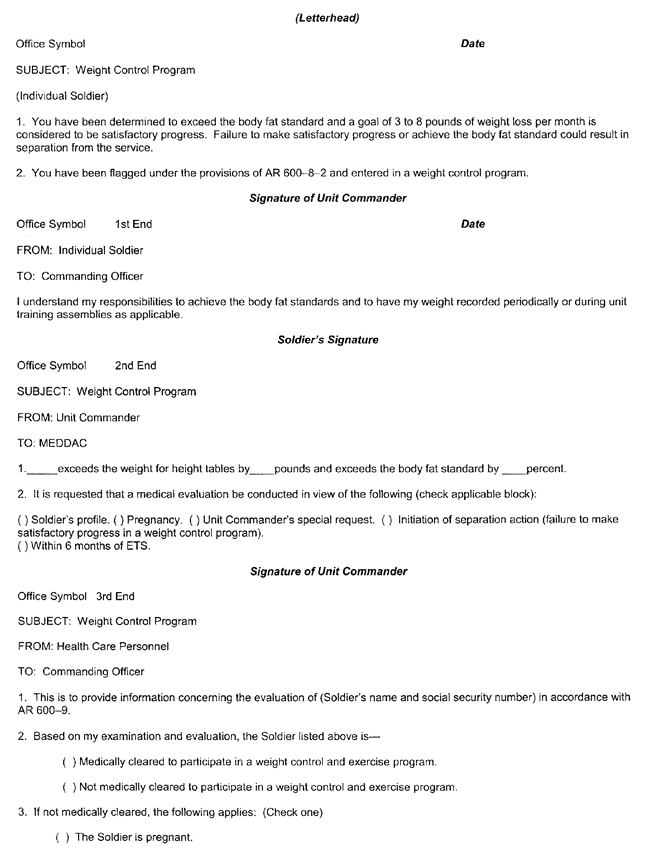
Figure 3–1. Sample correspondence for weight control program
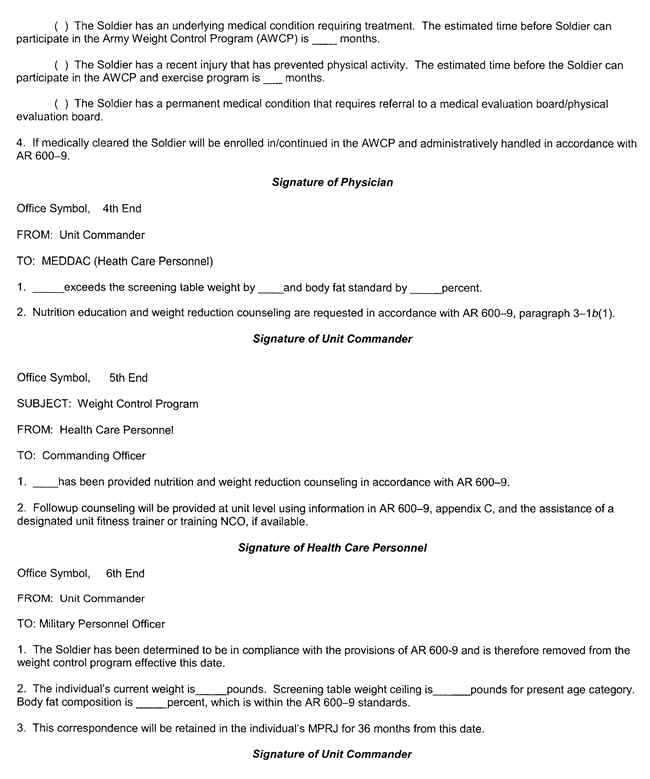
Figure 3–1. Sample correspondence for weight control program—Continued
d. Health care personnel will perform a medical evaluation when a Soldier has a medical limitation, is pregnant, or when requested by the unit commander. A medical evaluation is also required for Soldiers being considered for separation because of a failure to make satisfactory progress in the AWCP, or within 6 months of ETS. Aircraft crewmembers who exceed the body fat standards will be referred to a flight surgeon for possible impact on flight status. The medical professional will—
(1) Conduct a thorough medical evaluation to rule out any underlying medical condition (for example, a metabolic disorder) that may be a cause for significant weight gain. If an underlying medical condition cannot be controlled with medication or other medical treatment, the medical professional will refer the Soldier to a medical evaluation board (MEB).
(2) Prepare any profile associated with the underlying diagnosis in accordance with AR 40-501, chapter 7. Temporary or permanent profiles will not be granted to exempt Soldiers from the requirement to meet body fat standards; therefore, such profiles will be deemed invalid.
(3) Complete a memorandum to the Soldier’s unit commander.
(4) The sample correspondence shown in figure 3–1 will be completed and retained by the unit commander or supervisor to properly document recommendations and actions taken in each case. The use of certain medications to treat an underlying medical disorder or the inability to perform all aerobic events may contribute to weight gain but are not considered sufficient justification for noncompliance with this regulation. If an individual’s weight condition, as diagnosed by medical authorities, results from an underlying or associated disease process, health care personnel will take one of the following actions:
(a) Prescribe treatment to alleviate the condition and return the Soldier to the unit. A physician must note the approximate amount of time treatment is needed before the Soldier can be continued in the AWCP. For instance, a Soldier who is medicated for an underactive thyroid gland may need 3 months before the medication enables the Soldier to begin to lose weight at the same rate as an individual with a normal functioning thyroid gland. This is not a permanent exemption from this regulation. Soldiers will not be permanently exempt because of chronic medical conditions.
(b) Hospitalize Active Army personnel for necessary treatment.
(c) Refer Reserve Component personnel to their personal physicians (at an individual’s expense) for further evaluation or treatment.
(d) Provide personalized nutritional and exercise counseling based on medical diagnosis.
(e) Determine whether an individual’s condition is medically disqualifying for continued service. If the Soldier does not meet medical retention standards of AR 40-501, chapter 3, the Soldier will be referred to an MEB/physical evaluation board (PEB).
e. If the underlying medical condition does not require referral to an MEB/PEB and a Soldier is classified as overweight, these facts will be documented and the Soldier will be entered into the AWCP except as described in paragraph 3–2_b_. Commanders will initiate suspension of favorable personnel actions under AR 600–8–2.
(1) The required weight loss goal of 3 to 8 pounds per month is considered a safely attainable goal to enable Soldiers to lose excess body fat and meet the body fat standards described in paragraph 3–1_c_. Weigh-ins will be made by unit personnel monthly (or during unit assemblies for ARNG and USAR personnel) to measure progress. A body fat evaluation may also be done by unit personnel to assist in measuring progress.
(2) As an exception to paragraph 3–2_g_, an individual who has not made satisfactory progress after any two consecutive monthly weigh-ins may be referred by the commander or supervisor to health care personnel for evaluation or reevaluation. If health care personnel are unable to determine a medical reason for lack of weight loss—and if the individual is not in compliance with the body fat standards at paragraph 3–1_c_ and still exceeds the screening table weight (table 3–1)—the commander or supervisor will inform the individual that—
(a) Progress is unsatisfactory.
(b) He or she is subject to separation as specified in paragraph 3–2_j_.
f. Commanders and supervisors will remove individuals administratively from a weight control program as soon as the body fat standard is achieved. The screening table weight will not be used to remove Soldiers from a weight control program. The removal action will be documented as shown in figure 3–1; removal of suspension of favorable personnel actions will be accomplished at that time.
g. After a period of dieting and/or exercise for 6 months and except as described in paragraph 3–2_b_, Soldiers who have not made satisfactory progress and who still exceed the screening table and body fat standards will be processed as follows:
(1) If health care personnel determine that the condition is due to an underlying or associated disease process, action described in paragraph 3–2_d_ will be taken.
(2) The unit commander will initiate a mandatory bar to reenlistment or administrative separation proceeding for Soldiers who do not make satisfactory progress in the AWCP after a 6-month period and for whom no medical reasons exist to cause the overweight condition. The appropriate regulatory guidance is located in paragraph 3–2_j_.
h. Personnel will be continued in a weight control program (as provided in paragraphs 3–2_e_ through g) after the initial 6–month period, except as described in paragraph 3–2_b_, if they—
(1) Still exceed the body fat standard.
(2) Have made satisfactory progress toward their weight loss (as indicated in the glossary), or are at or below the screening table weight (table 3–1).
(3) For RC personnel only, if the individual has not obtained an evaluation from his/her personal physician under the provisions of paragraph 3–2_d_ and cannot demonstrate that the overweight condition results from an underlying or associated disease process, the individual may be separated under appropriate regulations without further medical evaluation by health care personnel.
i. To assist commanders and supervisors, a flow chart outlining procedural guidance is shown at figure 3–2.
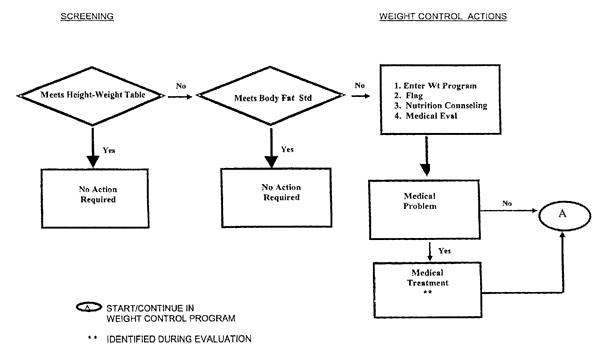
Figure 3–2. Flow process guide for screening and weight control actions (applies to all personnel: officers, warrant officers, and enlisted)
j. The commander or supervisor will inform the Soldier in writing that a bar to reenlistment or separation proceedings are being initiated under the following regulations: AR 135–175; AR 135–178; AR 600–8–24, chapters 4 and 5; AR 601–280; AR 635–200, chapters 5 through 15, and 18; NGR 600–5; NGR 600–101; NGR 600–200, chapter 7; or NGR 635–100. These actions will be taken unless a medical reason is found to preclude the loss of weight or there are other good causes to justify additional time in the AWCP.
(1) The individual will immediately respond to the separation consideration letter in writing. The commander or supervisor will consider the response and initiate separation action if no adequate explanation is provided, unless the individual submits an application for retirement, if eligible. USAR personnel who fall under the purview of this paragraph will be released from AD or discharged, as appropriate.
(2) If separation action is not initiated or does not result in separation, the individual will be entered or continued in a weight control program, as specified in paragraph 3–2_e_.
k. If, within 36 months following removal from a weight control program, it is determined (under paragraph 3–2_a_) that an individual exceeds the screening table weight (table 3–1) and the body fat standard prescribed in paragraph 3–1_c_, the following will apply:
(1) If the unit commander determines that the individual exceeds the body fat standard—
(a) Within 12 months following removal from the AWCP and no underlying or associated disease process is found as the cause of the condition, the unit commander will initiate separation proceedings per paragraphs 3–2_g_ and j.
(b) After the 12th month, but within 36 months from the date of the previous removal from the program, and if no underlying or associated disease process is found as the cause of the condition, the individual will be allowed 90 days to meet the standards. Personnel who meet the body fat standard after that period will be removed from the program. All others will be subject to separation from the service under paragraph 3–2_j_.
(c) Personnel who meet this regulations’s standards and become pregnant will be exempt from the standards for the duration of the pregnancy plus the period of convalescent leave after termination of pregnancy. They will be entered in a weight control program, if required, after completion of 135 days of convalescent leave and with approval of a medical doctor that they are fit for participation in a weight control program. This procedure also applies to individuals in a medical holding unit who have been hospitalized for long periods. Soldiers entered/reentered in a weight control program after pregnancy, prolonged treatment, or hospitalization will be considered to be in a new weight control program. Paragraph 3–2_k_ of this regulation will not apply at that time.
(2) If the individual is determined to exceed the body fat standard and the condition is due to an underlying or associated disease process, action described in paragraph 3–2_d_ will be taken.
l.
Inherent in the responsibility of selection boards is the obligation to select only those individuals who are considered to be physically fit to perform the duties required of them at all times. Compliance with the AWCP as prescribed in this regulation will be considered in the selection process for promotion, professional military or civilian schooling, or assignment to command positions. Procedures for commanders and supervisors to provide current information for use by selection boards indicating whether individuals meet the prescribed standards will be included in DA regulations or issued by separate correspondence.
m.
Records will be maintained in the Military Personnel Records Jacket for personnel in weight control programs. On transfer from one unit to another, the losing commander or supervisor will forward a statement to the gaining unit with information indicating the status of the individual’s participation in a weight control program. When the transfer is a permanent change of station, the unit commander’s statement will be filed as a transfer document in the Military Personnel Records Jacket, under AR 600–8–104.
n.
Upon removal from the weight control program, unit records on participation in a weight control program will be maintained in the Military Personnel Records Jacket for a period of 36 months from date of removal. If the Soldier is transferred to another unit prior to completion of 36 months, action will be taken in accordance with paragraph 3–2_m_.
3–3. Reenlistment criteria
a. Personnel who exceed the screening table weight at table 3–1 and the body fat standard for their current age group in paragraph 3–1_c_ will not be allowed to reenlist or extend their enlistment.
b. Exceptions to policy for Active Army personnel (including RC personnel on AD) are prescribed in this subparagraph. For Soldiers who are otherwise physically fit and have performed their duties in a satisfactory manner, the commander exercising General Court-martial Convening Authority or the first general officer in the Soldier’s normal chain of command (whichever is in the most direct line to the Soldier) may approve the following exceptions to policy:
(1) Extension of enlistment may be authorized for personnel who meet one of the following criteria:
(a) Individuals who have a temporary medical condition that precludes loss of weight. In such cases, the type of ongoing treatment will be documented; the extension will be for the minimum time necessary to correct the condition and achieve the required weight loss.
(b) Pregnant Soldiers (except those Soldiers who have medical conditions as listed in paragraph 3–2_d_) who are otherwise fully qualified for reenlistment, including those with approved waivers, but who exceed acceptable standards prescribed in this regulation, will be extended for the minimum period that will allow birth of the child, plus 6 months. A clearance from the doctor that the Soldier is medically fit to participate in a weight control program is required. Authority, which will be cited on DA Form 1695 (Oath of Extension of Enlistment), is AR 601–280, paragraph 3–3. On completion of the period of extension, the Soldier will be reevaluated under paragraph 3–2.
(2) Exceptions to policy allowing reenlistment/extension of enlistment are authorized only in cases where—
(a) Medically documented conditions (para 3–2_d_) preclude attainment of required standards.
(b) Disability separation is not appropriate.
c. All requests for extension of enlistment for ARNG and USAR (TPU and IRR) personnel not on AD will be processed under NGR 600–200 or AR 140–111, chapter 3, as appropriate.
d. Requests for exceptions to policy will be forwarded through the chain of command, with the commander’s personal recommendation and appropriate comment at each level. As a minimum, requests will include—
(1) The physician’s evaluation.
(2) A record of progress in the weight control program.
(3) Current height and weight.
(4) Body fat content.
(5) Years of active Federal service.
(6)
Other pertinent information.
e. Soldiers who have completed a minimum of 18 years of active Federal service may, if otherwise eligible, be extended for the minimum time required to complete 20 years active Federal service. Retirement must be accomplished not later than the last day of the month in which the Soldier attains retirement eligibility. Application for retirement will be submitted at the time extension is authorized. Approval/disapproval authority is outlined in AR 601–280.
f. USAR Soldiers who have completed a minimum of 18 years of qualifying service for retired pay at age 60 may be extended for the minimum time required to complete 20 years qualifying service. Approval/disapproval authority is outlined in AR 140–111. Transfer to the IRR, Retired Reserve, or discharge will be accomplished at the end of the retirement year in which the Soldier attains the 20 qualifying years.
g. ARNG Soldiers who have completed a minimum of 18 years qualifying service for retired pay at age 60 may be extended for the minimum time required to complete 20 years qualifying service by the State Adjutant General; disapproval authority is the CNGB. Transfer to the IRR, Retired Reserve, or discharge will be accomplished at the end of the retired year in which the Soldier attains the 20 qualifying years.
Appendix A References
Section I Required Publications
AR 135–175 Separation of Officers. (Cited in para 3–2_j_.)
AR 135–178 Enlisted Administrative Separations. (Cited in para 3–2_j_.)
AR 140–111 U.S. Army Reserve Reenlistment Program. (Cited in para 3–3_c_.)
AR 600–8–2 Suspension of Favorable Personnel Actions (FLAGS). (Cited in para 3–2_b, e_.)
AR 601–280 Army Retention Program. (Cited in paras 3–2_j_, 3–3_b_(1)(b).)
AR 600–8–24 Officer Transfers and Discharges. (Cited in para 3–2_j_.)
AR 635–200 Active Duty Enlisted Administrative Separations. (Cited in para 3–2_j_.)
AR 600–8–104 Military Personnel Information Management/Records. (Cited in para 3–2_m_.)
NGR (AR) 600–5 The Active Guard/Reserve (AGR) Program, Title 32, Full-Time National Guard Duty (FTNGD). (Cited in para 3–2_j_.)
NGR 600–101 Warrant Officers—Federal Recognition and Related Personnel Activities. (Cited in para 3–2_j_.)
NGR 600–200 Enlisted Personnel Management. (Cited in para 3–2_j_.)
NGR 635–100 Termination of Appointment and Withdrawal of Federal Recognition. (Cited in para 3–2_j_.)
DODI 1308.3 DOD Physical Fitness and Body Fat Programs Procedures.
Section II Related Publications
A related publication is a source of additional information. The user does not have to read a related publication to understand this publication.
AR 40–25 Nutrition Standards and Education
AR 40–501 Standards of Medical Fitness.
Appendix B Standard Methods for Determining Body Fat Using Body Circumferences, Height, and Weight
B–1. Introduction
a. The procedures for the measurements of height, weight, and specific body circumferences for the estimation of body fat are described in this appendix.
b. Although circumferences may be looked upon by untrained personnel as easy measures, they can give erroneous results if proper precautions are not followed. The individual taking the measurements must have a thorough understanding of the appropriate body landmarks and measurement techniques. Unit commanders will require that designated personnel have hands-on training and read the instructions regarding technique and location and practice before official determinations are made. Two members of the unit will be utilized in the taking of measurements, one to place the tape measure and determine measurements, the other to assure proper placement and tension of the tape, as well as to record the measurement on the worksheet (DA Form 5500 (Body Fat Content Worksheet (Male) and DA Form 5501 (Body Fat Content Worksheet (Female)). The individual taking the measurements will be of the same sex as the Soldier being measured; the individual who assists the measurer and does the recording may be of either sex. The two will work with the Soldier between them so the tape is clearly visible from all sides. Take all circumference measurements three times and record them to the nearest 1⁄2 inch. If any one of the three closest measurements differs by more than 1 inch from the other two, take an additional measurement and compute a mathematical average of the three measurements with the least difference to the nearest 1⁄2 inch and record this value.
c. When measuring circumferences, compression of the soft tissue is a problem that requires constant attention. The tape will be applied so that it makes contact with the skin and conforms to the body surface being measured. It will not compress the underlying soft tissues. Note, however, that in the hip circumference more firm pressure is needed to compress gym shorts. All measurements are made in the horizontal plane (parallel to the floor), unless indicated otherwise.
d. The tape measure will be made of a nonstretchable material, preferably fiberglass; cloth or steel tapes are unacceptable. Cloth measuring tapes will stretch with usage and most steel tapes do not conform to body surfaces. The tape measure will be calibrated—that is, compared with a yardstick or a metal ruler to ensure validity. This is done by aligning the fiberglass tape measure with the quarter inch markings on the ruler. The markings will match those on the ruler; if not, do not use that tape measure. The tape will be 1⁄4- to 1⁄2-inch wide (not exceeding 1⁄2 inch) and a minimum of 5 to 6 feet in length. A retractable fiberglass tape is the best type for measuring all areas. Tapes currently available through the Army Supply System (Federal Stock Number 8315–00–782–3520) may exceed the 1⁄2-inch width limits and could slightly impact on circumferential measurements. Efforts are being made to replace the supply system tape with a narrower retractable tape. In the interim, the current Army supply system or any other fiberglass tape not to exceed 5⁄8 inch may be used if retractable tapes cannot be purchased by unit budget funds available and approved by installation commanders.
B–2. Height and weight measurements
a. The height will be measured with the Soldier in stocking feet (without shoes) and standard PT uniform (gym shorts and T-shirt), standing on a flat surface with the head held horizontal, looking directly forward with the line of vision horizontal, and the chin parallel to the floor. The body will be straight but not rigid, similar to the position of attention. Unlike the screening table weight this measurement will be recorded to the nearest 1⁄2 inch in order to gather a more accurate description of the Soldier’s physical characteristics.
b. The weight will be measured with the Soldier in a standard PT uniform (gym shorts and T-shirt). Shoes will not be worn. The measurement will be made on scales available in units and recorded to the nearest pound with the following guidelines:
(1) If the weight fraction of the Soldier is less than 1⁄2 pound, round down to the nearest pound.
(2) If the weight fraction of the Soldier is 1⁄2 pound or greater, round up to the next whole pound.
B–3. Description of circumference sites and their anatomical landmarks and technique
a. All circumference measurements will be taken three times and recorded to the nearest 1⁄2-inch (or 0.50). Each sequential measurement will be within 1⁄2 inch of the next or previous measurement. If the measurements are within 1⁄2 inch of each other, derive a mathematical average to the nearest 1⁄2 of an inch. If the measurements differ by 1⁄2 inch or more continue measurements until you obtain three measures within 1⁄2 inch of each other. Then average the three closest measures.
b. Each set of measurements will be completed sequentially to discourage assumption of repeated measurement readings. For males, complete 1 set of abdomen and neck measurements, NOT three abdomen circumferences followed by three neck circumferences. Continue the process by measuring the abdomen and neck in series until you have three sets of measurements. For females, complete one set of neck, waist (abdomen), and hip measurements, NOT 3 neck followed by three waist (abdomen), and so on. Continue the process by measuring neck, waist (abdomen), and hip series until you have 3 sets of measurements.
c. Sample worksheets and instructions for computing body fat are at figures B–1 and B–2 (males) and figures B–3 and B–4 (females). Percent fat estimates are show in figures B–5 (males) and B–6 (females).
d. Illustrations of each tape measurement are at figures B–7 (males) and figure B–8 (females). A training videotape is also available at Visual Information Libraries and/or Training Audiovisual Support Centers.
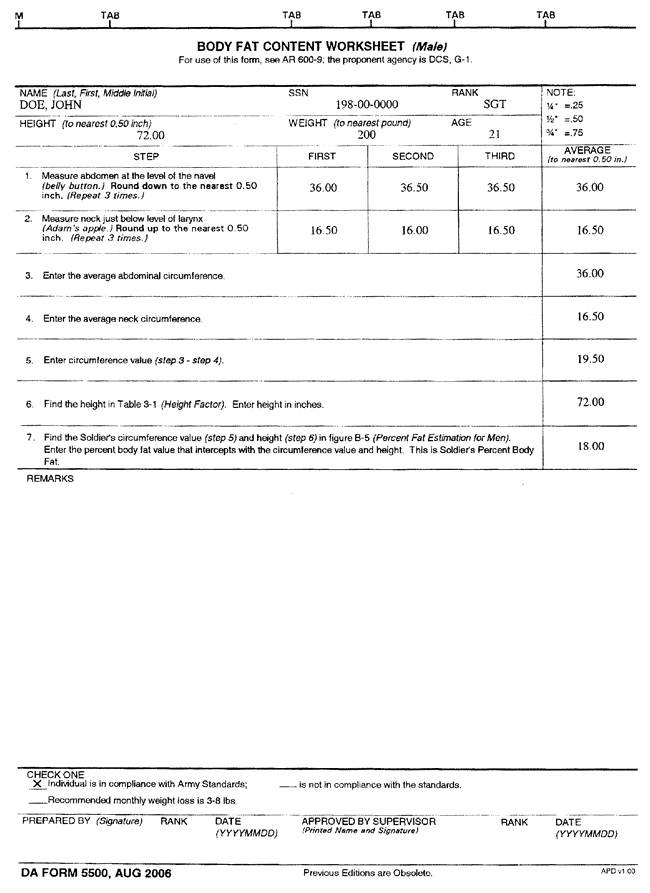
Figure B–1. Sample DA Form 5500
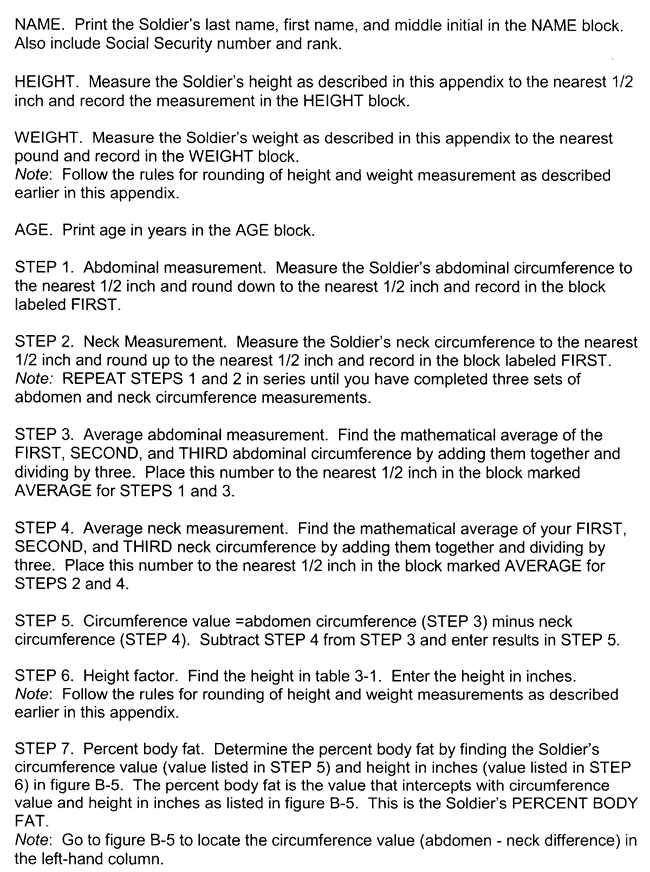
Figure B–2. Instructions for completing DA Form 5500
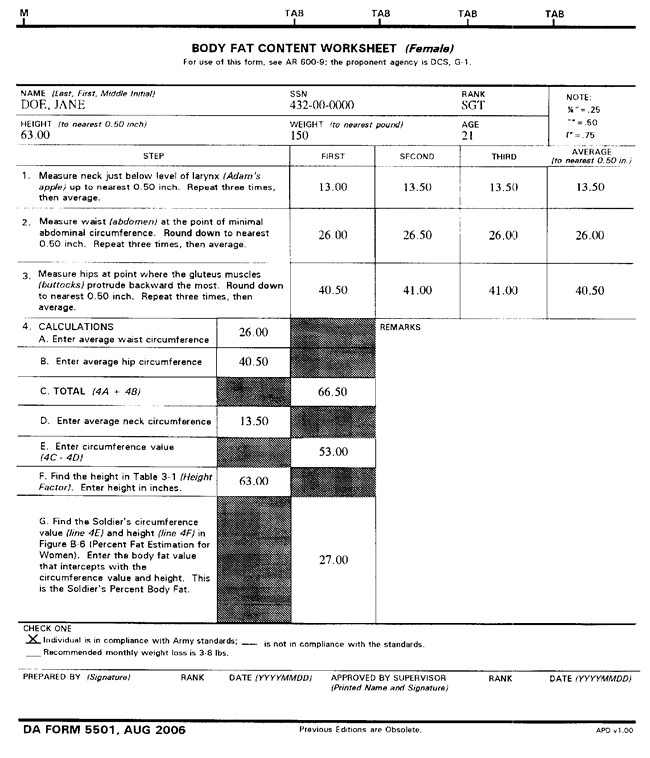
Figure B–3. Sample DA Form 5501
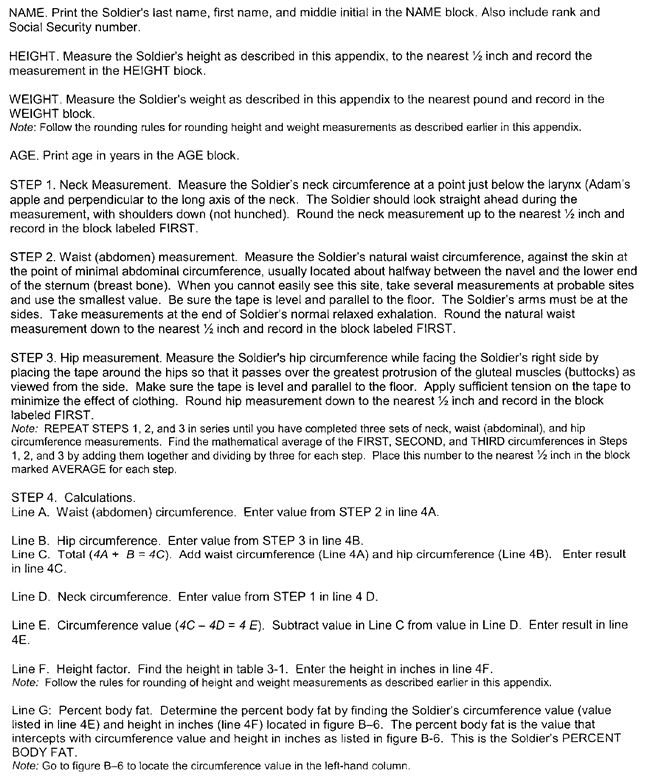
Figure B–4. Instructions for completing DA Form 5501
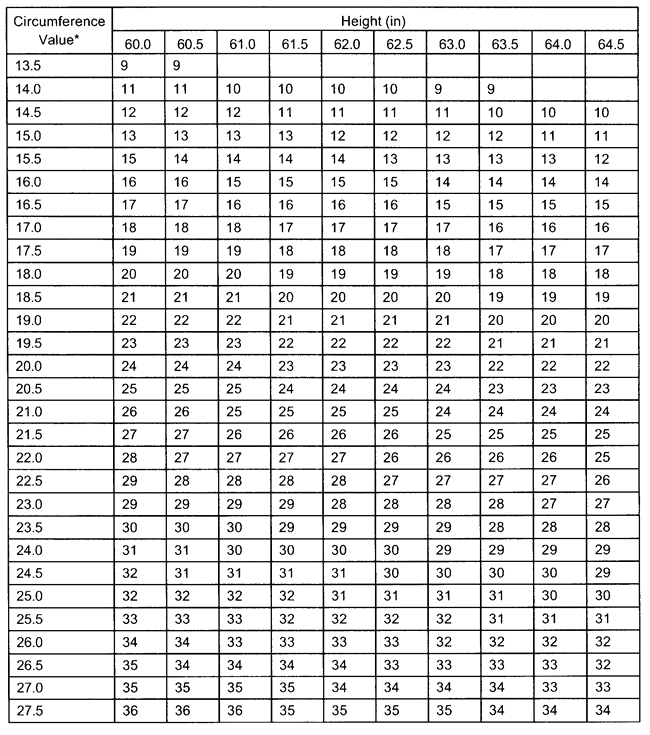
Figure B–5. Percent fat estimates for males
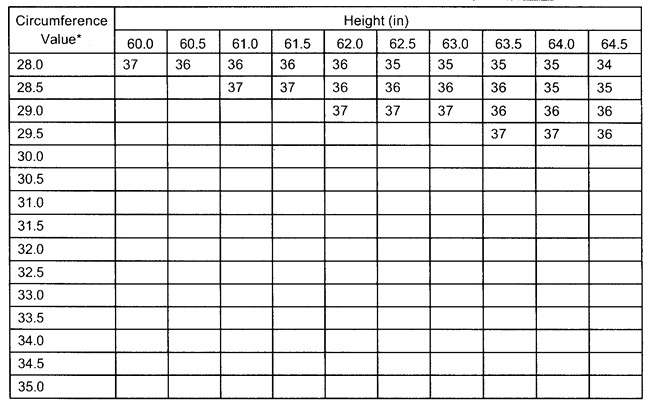
Figure B–5. Percent fat estimates for males—Continued
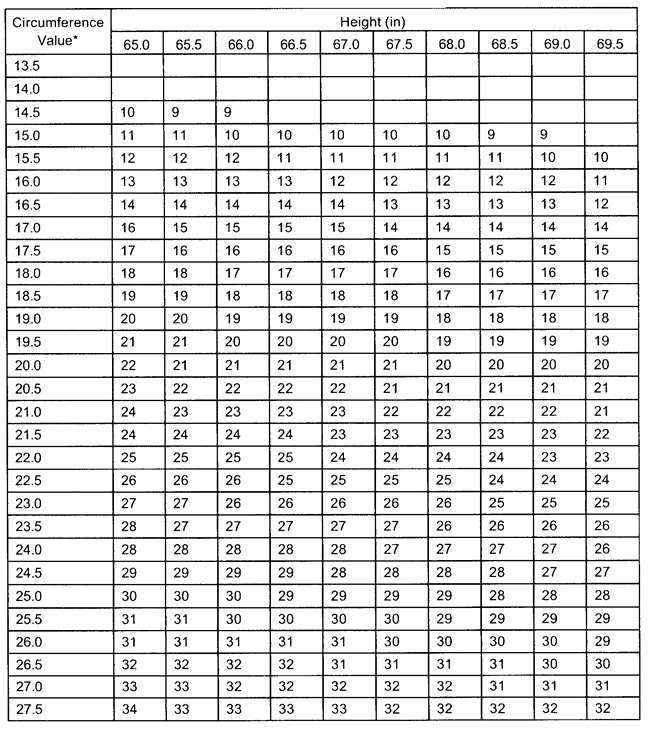
Figure B–5. Percent fat estimates for males—Continued
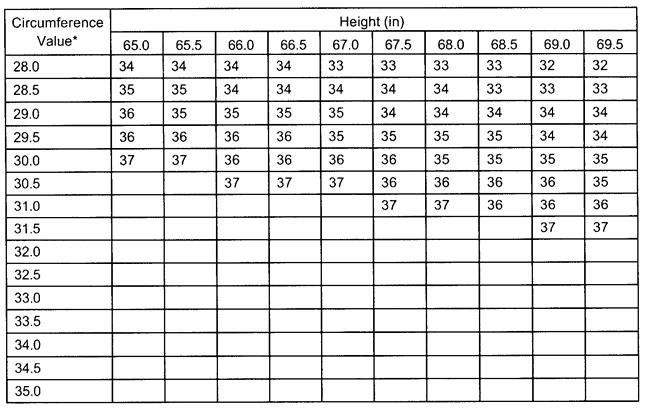
Figure B–5. Percent fat estimates for males—Continued

Figure B–5. Percent fat estimates for males—Continued
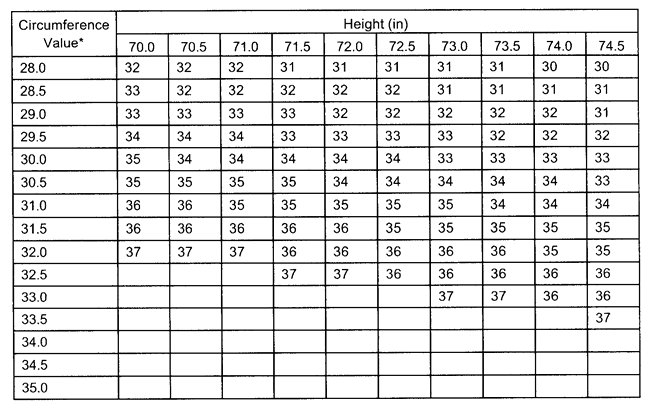
Figure B–5. Percent fat estimates for males—Continued
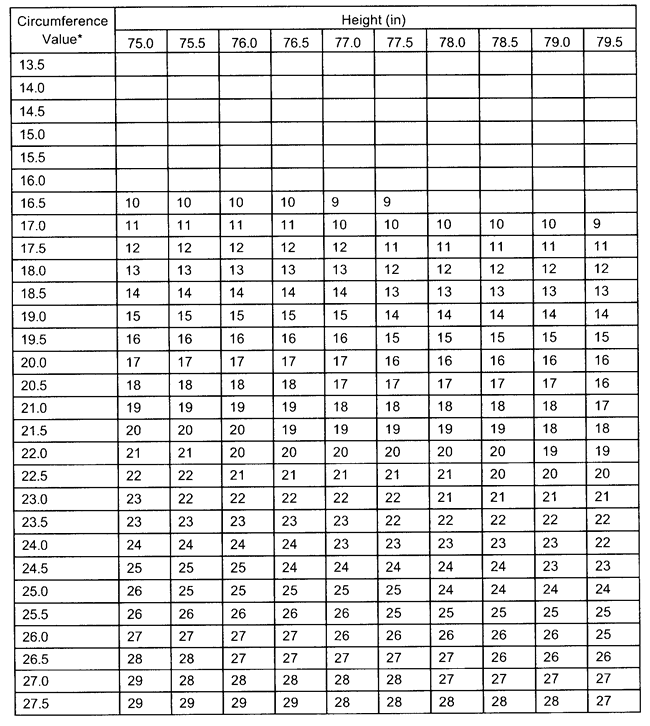
Figure B–5. Percent fat estimates for males—Continued
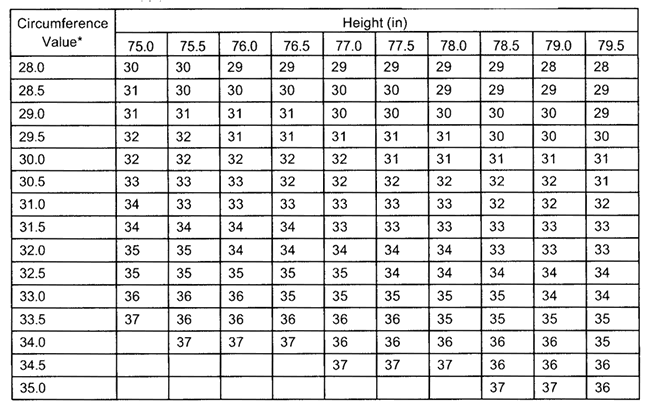
Figure B–5. Percent fat estimates for males—Continued
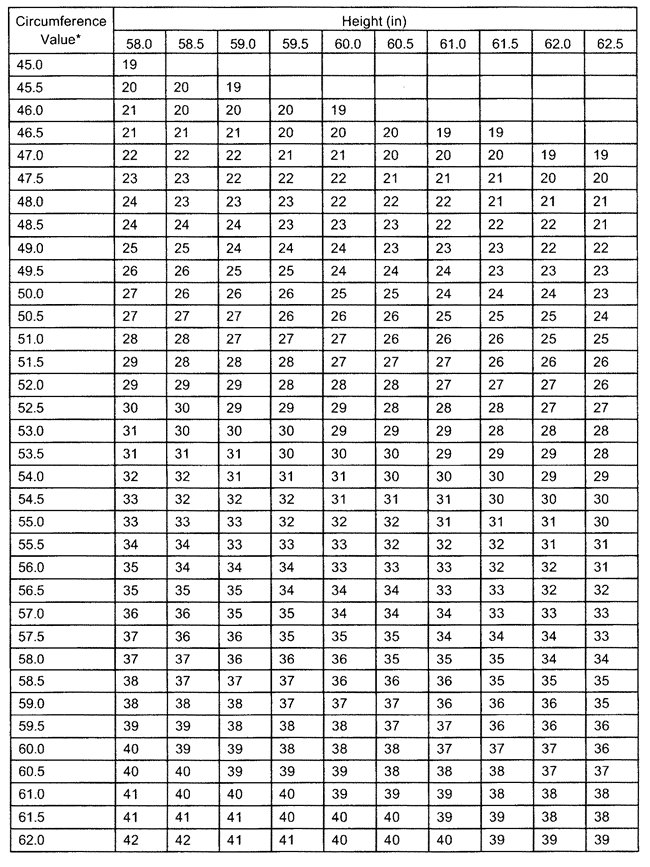
Figure B–6. Percent fat estimates for females
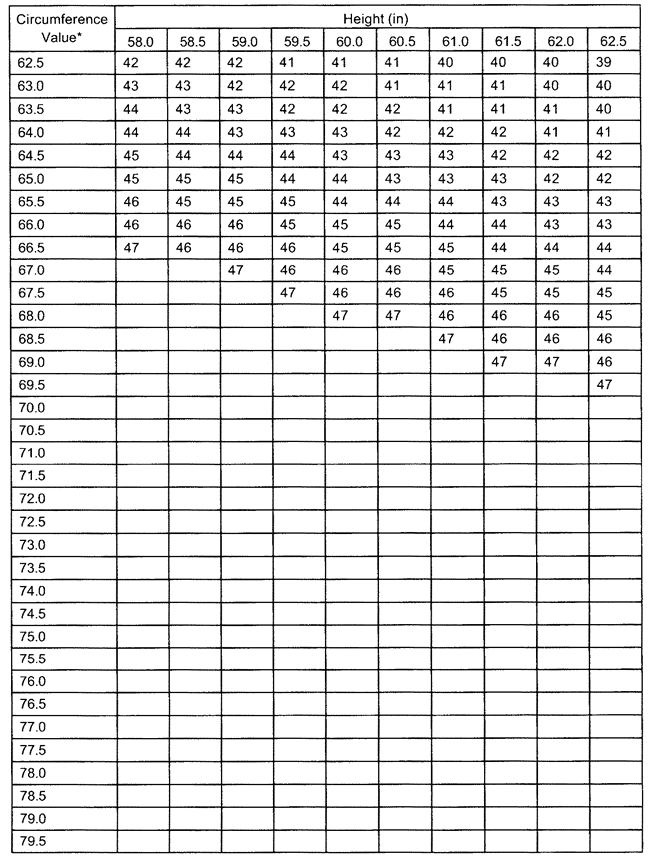
Figure B–6. Percent fat estimates for females—Continued
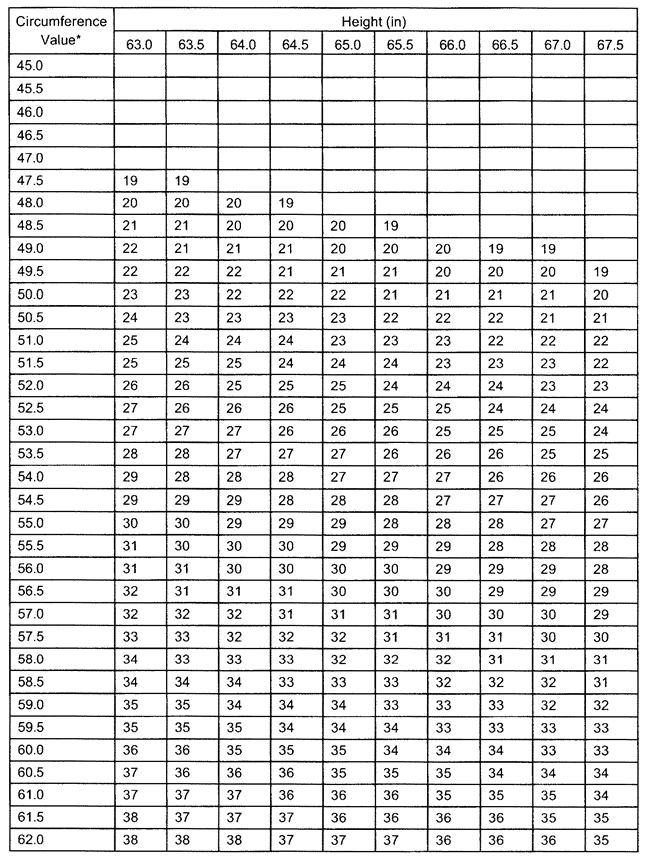
Figure B–6. Percent fat estimates for females—Continued
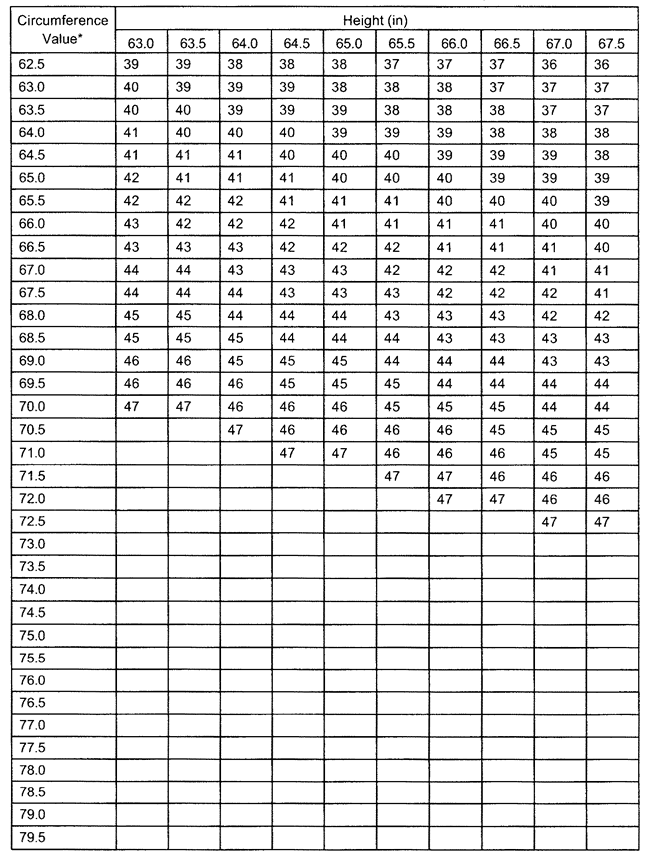
Figure B–6. Percent fat estimates for females—Continued

Figure B–6. Percent fat estimates for females—Continued
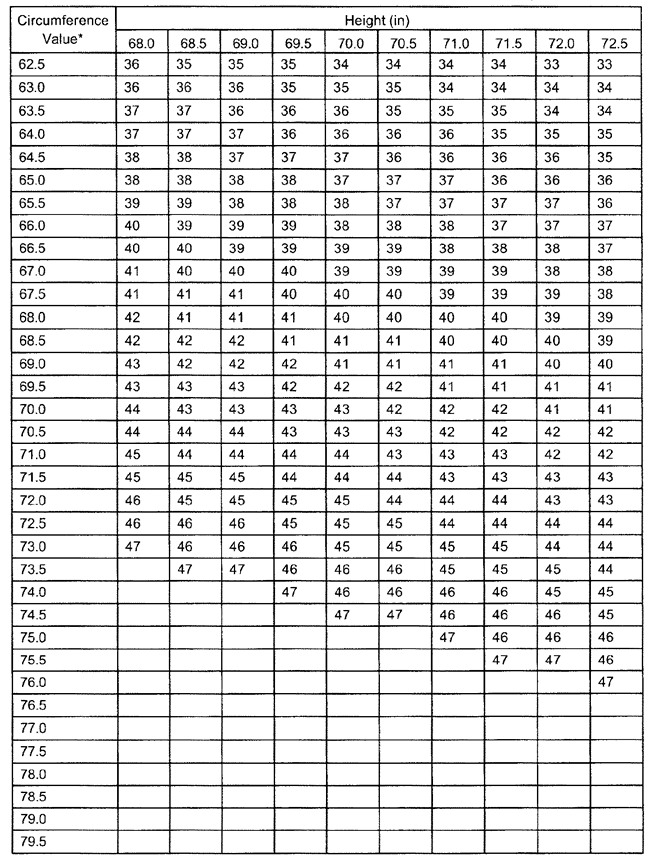
Figure B–6. Percent fat estimates for females—Continued

Figure B–6. Percent fat estimates for females—Continued

Figure B–6. Percent fat estimates for females—Continued
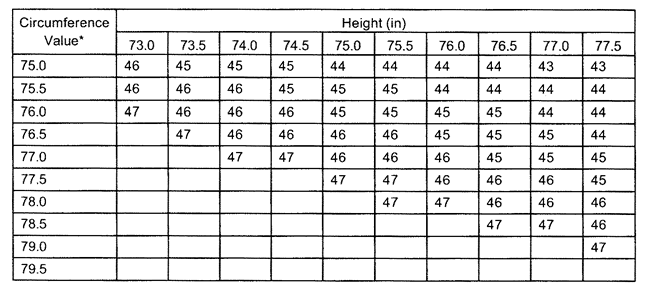
Figure B–6. Percent fat estimates for females—Continued
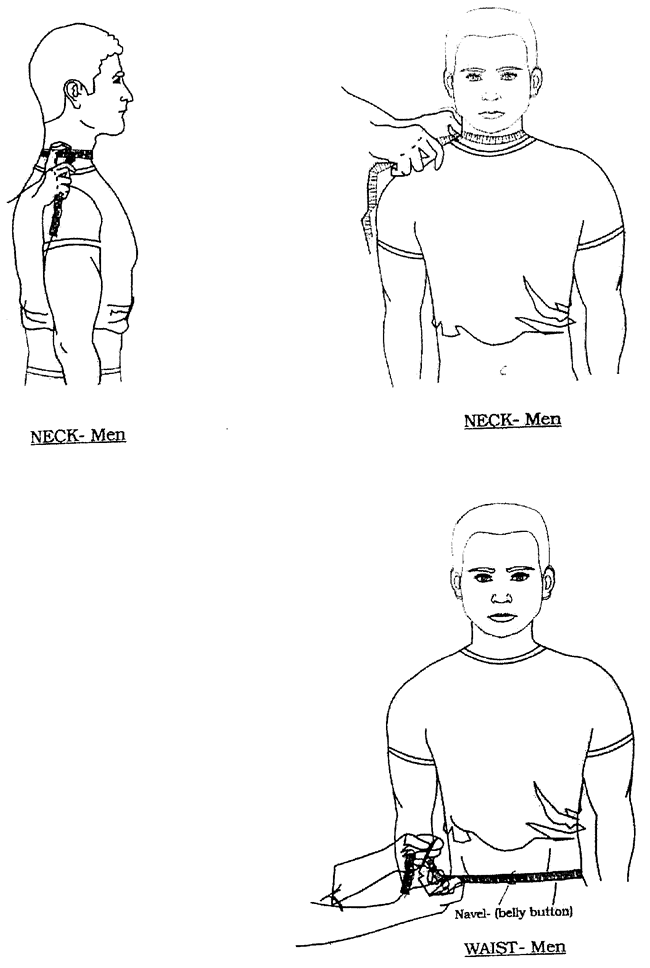
Figure B–7. Male tape measurement illustration
Figure B–8. Female tape measurement illustration
B–4. Circumference sites and landmarks for males
a. Abdomen. Measure abdominal circumference against the skin at the navel (belly button), level and parallel to the floor. Arms are at the sides. Record the measurement at the end of Soldier’s normal, relaxed exhalation. Round abdominal measurement down to the nearest 1⁄2 inch and record (for example, round 343⁄4 to 341⁄2).
b. Neck. Measure the neck circumference at a point just below the larynx (Adam’s apple) and perpendicular to the long axis of the neck. Do not place the tape measure over the Adam’s apple. Soldier will look straight ahead during measurement, with shoulders down (not hunched). The tape will be as close to horizontal as anatomically feasible (the tape line in the front of the neck will be at the same height as the tape line in the back of the neck). Care will be taken so as not to involve the shoulder/neck muscles (trapezius) in the measurement. Round neck measurement up to the nearest 1⁄2 inch and record (for example, round 161⁄4 inches to 161⁄2 inches).
B–5. Circumference sites and landmarks for females
a. Neck. This procedure is the same as for males.
b. Waist. Measure the natural waist circumference, against the skin, at the point of minimal abdominal circumference. The waist circumference is taken at the narrowest point of the abdomen, usually about halfway between the navel and the end of the sternum (breast bone). When this site is not easily observed, take several measurements at probable sites and record the smallest value. The Soldier’s arms must be at the sides. Take measurements at the end of Soldier’s normal relaxed exhalation. Tape measurements of the waist will be made directly against the skin. Round the natural waist measurement down to the nearest 1⁄2 inch and record (for example, round 285⁄8 inches to 281⁄2 inches).
c. Hip. The Soldier taking the measurement will view the person being measured from the side. Place the tape around the hips so that it passes over the greatest protrusion of the gluteal muscles (buttocks) keeping the tape in a horizontal plane (parallel to the floor). Check front to back and side to side to be sure the tape is level to the floor on all sides before the measurements are recorded. Because the Soldier will be wearing gym shorts, the tape can be drawn snugly to minimize the influence of the shorts on the size of the measurement. Round the hip measurement down to the nearest 1⁄2 inch and record (for example, round 443⁄8 inches to 44 inches).
B–6. Preparation of the body fat content worksheets
It is extremely important that you read all of these instructions before attempting to complete the body fat content worksheets. Have a copy of the worksheet when reading these instructions.
a. Figures B–1 through B–8 will provide information needed to prepare the percentage fat worksheets for males (DA Form 5500) and females (DA Form 5501). The worksheets are written in a stepwise fashion. The measurements and computation processes are different for males and females.
b. A worksheet must be completed for Soldiers who exceed the screening table weight (table 3–1) or when a unit commander or supervisor determines that the individual’s appearance suggests that body fat is excessive (para 3–1_a_). The purpose of this form is to help determine the Soldier’s percent body fat using the circumference technique described in this regulation.
c. Before starting, have a thorough understanding of the measurements to be made as outlined in this appendix. A scale for measuring body weight, a height measuring device, and a measuring tape (see specifications in para B–1_d_) for the circumference measurements are also required.
Appendix C Nutrition Guide to the Weight Control Program
C–1. General
This appendix explains the basic principles of weight loss while maintaining normal nutrition. It does not replace the requirement for Active Army and RC units with Soldiers exceeding the body fat standards to be provided weight reduction counseling by qualified health care personnel. This guide will be used as a supplement to weight reduction counseling and as a guide for commanders in developing an effective weight control program.
C–2. Weight control—it’s time to make the fitness connection
In many cases fitness begins with weight reduction. Aerobic fitness is related to an individual’s body fat. The higher the fat, the less likely the individual is to be aerobically fit and the harder it is to maintain higher levels of physical stamina and endurance. A fit Army is a lean Army. Military readiness demands weight control—the spin-off is less likelihood of developing heart disease, high blood pressure, and diabetes. Proper nutrition and regular exercise are necessary to help lose weight and improve a state of fitness.
a. Invest in yourself.
(1) Make a decision to lose weight and shape up.
(2) Get motivated.
(3) Develop a strategy (diet, exercise routine, lifestyle changes, and so on).
(4) Carry out the strategy.
b. Enjoy the payoffs:.
(1) A healthy appearance.
(2) An improved self-image.
(3) A sense of accomplishment.
(4) A feeling of pride.
C–3. Making nutrition work
Improving your nutrition will increase your mileage in many ways. You can even lose weight while improving performance. Your nutrition program will include the right number of calories to cause a steady loss of body fat with no loss of energy. Stay away from food fads—they are usually boring, unhealthy, and too strict and will lead only to temporary weight loss. Compare the benefits of a sound nutrition with the consequences of crash diets, as shown in table C–1.
Table C–1 Nutrition
Sound Nutrition: Provides all required nutrients Crash Diets: Most often lack some nutrients
Sound Nutrition: Gradual loss of body fat (1 to 2 pounds per week) Crash Diets: Rapid loss of body water and muscle mass—not body fat
Sound Nutrition: Reinforces a good mental outlook Crash Diets: Symptoms of grumpiness, headaches, anxiety and fatigue
Sound Nutrition: Improves health Crash Diets: Can cause depression, dehydration, potential serious illness and a slowdown in your body’s metabolism (the rate your body burns calories)
Sound Nutrition: Gives a sense of accomplishment Crash Diets: End in eventual weight loss and failure
Sound Nutrition: Develops permanent good eating habits Crash Diets: Encourage unhealthy eating habits of temporary duration
C–4. Basic strategy checklist—a plan for making the right connection
a. Good attitude. Having a good mental attitude is necessary to succeed in any program. To lose weight, a good mental attitude helps self-discipline—an important ingredient.
b. Sensible nutrition. A diet of adequate essential nutrients is necessary to prevent mental and physical fatigue. Crash diets don’t work in a permanent weight control program.
c. Regular exercise. Exercise promotes physical fitness. It improves flexibility, strength, endurance and weight loss by speeding up the body’s metabolism. It has also been proven to help supress the appetite.
d. Diet and exercise master plan. Create your own daily food intake and exercise plan. Keep a record. Make adjustments. You are in control.
e. Rest. Adequate rest improves attitude, posture, and appearance. Lack of rest and sleep can weaken resistance and will power.
f. A set goal. See a long range objective, then get going by setting easier-to-reach short-term goals. After the first few goals are met, the objective will be in plain view.
C–5. Balance check
If you need to lose weight, it’s time to check your energy balance to see what’s tilting the scale. When your energy input (calories) is greater than your energy output (activity), you store the extra calories as body fat. To stay in balance:
a. Increase exercise (frequency and intensity).
b. Decrease calorie intake.
c. Combine exercise with calorie reduction for best results.
C–6. Obesity risks
Excess body fat is harmful to your health. It increases your risk for developing high blood pressure, diabetes, heart disease, respiratory infections, gall bladder disease, low-back pain, and some forms of cancer. It has further drawbacks in physical appearance and interferes with physical performance.
C–7. Tailoring a nutrition program
a. The best nutrition program is one that allows you to lose body fat while you eat regular wholesome foods in controlled portion sizes. Does your diet include essential nutrients? An easy way to check is shown in table C–2.
b. Activity factors (see fig C–1) for weight maintenance include—
(1) Weight maintenance.
(2) Activity factors:
(a) Sedentary. Twelve to 14 calories per pound are required if you are not involved in exercise on the job or off duty.
(b) Active. Fifteen calories per pound are required when your job involves physical work and/or you are engaged in a regular exercise program.
(c) Highly active. Sixteen to 18 calories are required per pound when very physically demanding work and/or high level of physical training is done routinely. (Most people do not fit in this category).
(3) Weight loss (see fig C–2).
(a) To lose 1 pound of fat per week, subtract 500 calories per day from your calorie maintenance level.
(b) To lose 2 pounds of fat per week, subtract 1,000 calories per day.
Table C–2 Diet structures
Food group
Recommended servings per day
Your diet
Milk (8 ozs) Meat (3 ozs) Bread or Cereal (1 slice or 1⁄2 cup) Vegetables 1⁄2 cup) Fruits (1 medium or 1/2 cup) Does your diet provide the right amount of calories?
2 2 4 2 2

Figure C–1. Weight maintenance formula

Figure C–2. Weight loss formula
C–8. What about calories
Calories don’t deserve a bad name unless your intake is greater than your requirement. Calories are provided by certain nutrients in the foods and beverages consumed. The nutrients listed in table C–3 provide calories; nutrients that do not provide calories are listed in table C–4.
Table C–3 Nutrient-calories guide
Nutrient: Carbohydrate (provides an efficient fuel source for the body.) Calories: 4 per gram
Nutrient: Protein (provides material to repair and build tissues.) Calories: 4 per gram
Nutrient: Fat (provides essential fatty acids and concentrated energy source for the body.) Calories: 9 per gram
Notes: 1 Alcohol, while not a nutrient, does provide calories (7 per gram).
Table C–4 Vitamins–minerals–water
Nutrient: Vitamins (needed to utilize the food you eat) Calories: 0
Nutrient: Minerals (needed for bones, teeth, and chemical functions) Calories: 0
Nutrient: Water (necessary for life) Calories: 0
C–9. Good nutrition—a personal choice
The amount of calories you consume depends on the type of food you choose, its preparation, and the amount you eat (PORTION SIZE). Some foods are very concentrated in calories (the portion size is small for the amount of calories it contains). Examples are fats, candy, fried foods, most deserts, and alcohol. These foods are also of low nutrient density—they provide few nutrients for the amount of calories provided (see table C–5 for comparison.)
Table C–5
High-calorie, low-nutrient foods
Food
Calories
1 piece of pecan pie
750
1 large apple
80
One-half fried chicken breast
400
One-half baked chicken breast
180
1 potato, French fried
275
1 baked potato
100
One-half cup syrup pack peaches
100
One-half cup unsweetened peaches
50
C–10. Portion control
a. You’ll need to learn to correctly estimate portion sizes in order to ensure adequate nutrition and to control intake. A guide to estimate portion sizes follows:
(1) 2 ounces=1 slice meat 3 x 4 inches and 1⁄4-inch thick (cooked).
(2) 3 ounces=1 meat pattie or portion (1/5 of a pound); 3-inch diameter, 1⁄2-inch thick (cooked).
(3) 3 ounces=one-half small chicken breast.
(4) 1 ounce=1 small chicken drumstick.
(5) 2 ounces=1 chicken thigh
(6)
1 ounce=1⁄4 cup chopped meat (tuna, spagetti meatsauce, chili, ground meat)
b. Some equal measurements are shown in table C–6.
Table C–6
Equal measurements
1 cup
=
8 ounces
1 tablespoon
=
3 teaspoons
1/4 cup
=
4 tablespoons
1 ounce
=
40 grams
1 liter
=
34 ounces
.7 liter
=
24 ounces
.5 liter
=
17 ounces
.2 liter
=
7 ounces
c. There is no single food that is so high in calories that a small amount cannot be eaten occasionally. Many people, however, have a particular food obsession that must be recognized. For them trying to eat “just a cookie, piece of candy, or sparerib” is too tempting. The urge to eat “the whole thing” becomes too great. You have to make and follow your own rules according to your ability to control what you eat. Avoidance is one means of control. But if you plan your diet, and diet according to your plan, you can include a favorite high calorie food item as a special occasional treat.
C–11. “Good cookin’ for good lookin”—a memo to the cook for cutting calories during food preparation
a. The milk and cheese group.
(1) Use skim or lowfat milk in recipes when making puddings, sauces, soups, and baked products.
(2) Substitute plain, unsweetened lowfat yogurt or blenderized lowfat cottage cheese in recipes that call for sour cream or mayonnaise.
b. The meat, poultry, fish, and dry beans group.
(1) TRIM fat from meat. Cook meats on rack so that fat can drain off.
(2) Roast, bake, broil, or simmer meat, poultry or fish without adding fat. Braise in covered pan on stove top or pan broil in a nonstick pan; and add spices to enhance flavors.
(3) Remove skin from chicken or turkey.
(4) Chill meat broth until fat turns light and solid on top. With a spoon or knife, skim or peel fat off and discard.
c. The vegetable and fruit group.
(1) Steam, boil, broil, or bake vegetables. Some fruits may be broiled or heated with spices added for flavor.
(2) Go easy on sauces, butter, and margarine. Season with herbs and spices. Crisp-cooked vegetables usually don’t require as much seasoning as overcooked vegetables.
(3) Try lemon juice or vinegar on salads. Cut way back on regular salad dressings. (One-fourth cup creamy dressing is approximately 340 calories!)
(4) Read nutrition information labels on food packages.
d. The bread and cereal group.
(1) Use less fat and sugar than called for in recipes. Substitute lower calorie ingredients.
(2) Avoid recipes for baked products that require large amounts of fat and sugar.
(3) Check ingredient labels for fat and sugar content. Check nutrition information label for total calories in each portion.
(4) Use diet margarine or plain yogurt on baked potatoes instead of margarine, butter, or sour cream.
(5) Have boiled, steamed, or baked rather than fried potatoes.
C–12. Dining tips
a. Avoid gravies, sauces, and deep-fried food. If the meat has been fried (southern style chicken, schnitzel), remove the coating and eat only the meat.
b. Remove all the visible fat from the meat.
c. Request diet salad dressing, vinegar, or lemon juice for your salad; most restaurants have them.
d. Starchy foods are not fattening when consumed in moderate quantities. However, avoid those prepared in cream sauces or deep-fried. For example, baked potatoes with a small amount of sour cream or margarine is a good choice. Also, noodles, rice, macaroni, or spaghetti are good potato substitutes.
e. Avoid rich desserts, ice cream, gelatin, pastry, candy, cookies, pies, cakes, sugar, honey, jam, jelly, regular soda, and other sweets. These are sources of concentrated calories that quickly cause your total intake to skyrocket in just a few bites. USE SPARINGLY, if you must.
f. If you MUST have a snack, have fresh fruits, a few crackers or pretzels, or delicious low-calorie raw vegetables.
g. Low-calorie beverages, black coffee, unsweetened sodas, and mineral water add no calories to your diet. Lowfat
milk is also a nutritious choice. Carry individually packaged sugar substitutes to sweeten beverages. Try a slice of lemon or lime in a glass of ice water.
h. Alcohol does have calories, as shown in table C–7.
Table C–7 Alcohol calories
Food Calories
American beer, 12 oz. 160
European beer, 1⁄2 liter 250
Cocktails, 4–6 oz. (1⁄2 cup) 165
Hard liquor, 11⁄2 oz. jigger 110
Dry wine, .25 litre (8 oz.) 200
Sweet wine, .25 liter (8 oz.) 300
C–13. Educate your appetite
a. Follow these tips to lose weight and body fat.
(1) Eat S-L-O-W-L-Y
(2) Consume less fat.
(3) Take smaller portions
(4) Consume less sugar.
(5) Take smaller bites
(6)
Chew food thoroughly
(7) Eat at least three regular meals per day.
(8) Plan snacks.
b. Plan your food intake and abide by your plan. Keep a food diary and monitor your own intake.
c. Always check your intake for balanced nutrition and total calories.
d. Become aware of how many calories you’re consuming- especially in snack foods. Table C–8 shows you why.
Table C–8 Sample calorie chart
Food Calories
Chocolate milkshake ( 8 oz.) 840
Coke, soda, or sugared beverage, 12 ozs. 160
French fries, 20 pieces (2″ x 1⁄2″) 275
Fruit pie (1/6th of 9-inch pie) 410
Pecan pie (1/6th of 9-inch pie) 750
Cheesecake (1/6th of 9-inch pie) 800
Ice cream, 2 scoops 200
Potato or corn chips, 1 ounce package 180
Chocolate candy, 1 ounce 150
Grapefruit or orange juice, 1 cup 100
Big Mac 557 Quarter-pounder with cheese 521
AAFES jumbo cheeseburger 654
Cottage cheese, creamed, 1 cup 223
Beer (European), 1/2 liter 250
Creamy salad dressing, 1/4 cup 340
Salted nuts: Peanuts, 2 tbs Cashews, 25 nuts 170
Mixed, 25 nuts 252 188
C–14. Easy ways to save calories
One sure way to save calories without reducing PORTION SIZE is to choose foods that are:
a. Lower in sugar. Each teaspoon supplies an additional 20 calories.
b. Lower in fat. (Each teaspoon supplies an additional 45 calories).
c. See tables C–9 and C–10 for easy ways to save calories. The Right Image of Me in the Military (TRIMM) sample meals are lower in fat and sugar—thus more”nutrient dense” and lower in calories. See table C–11 for the 1200–calorie daily menu and table C–12 for the 1500-calorie daily menu.
Table C–9 Weight control—a personal choice
Instead of—
Calories
Substitute with—
Calories
1 cup sweetened applesauce
232
Unsweetened applesauce
100
3 oz. beef bologna
237
Lean ham
103
1 oz. natural Swiss or cheddar
110
Part-skim milk mozzarella
90
cheese
1 cup cream-style cottage
223
Low-fat (1%) cottage cheese
125
cheese
1 oz. cream cheese
106
1 oz. Neufchatel cheese
70
1 cup vanilla ice cream
257
One-half cup vanilla ice cream
129
1 cup whole milk
170
Skim milk
80
3 oz. dry salami
384
Canned chicken
153
1 cup sour cream
454
Low-fat yogurt
123
One-half cup frozen sweetened
139
Frozen unsweetened strawber
118
strawberries
ries
One-half cup oil-pack tuna
158
Water-pack tuna
126
One-half cup syrup-pack
90
Drained/rinsed canned fruit
50
canned fruit
2 tablespoons mayonnaise
120
2 tablespoons mustard
24
4 tablespoons regular salad
300
4 tablespoons diet salad dress
80
dressing
1 piece fruit pie
410
1 piece fresh fruit
80
Notes: REMEMBER: A calorie saved is a calorie burned…and 3,500 calories is equal to a pound of body fat.
Table C–10 Comparison of regular and TRIMM meals
Food Item
Calories Food Item Calories
Cream of tomato soup (8 oz.)
Meat loaf (4 oz.)
Brown Gravy (3 oz.)
O’Brien potatoes
Club spinach (w/eggs) 1⁄2 cup
Tossed green salad (1 cup)
1000 Island Dressing (2 tbsp. or 1 oz.)
Yellow cake, chocolate frosting (3 inch squares.)
Milk, whole (8 fl. oz.) Totals
173 227 130 236
153 10 165
365
159 1618
Tomato bouillon (8 oz.) 36 Meat loaf (3 oz.) 170
Parsley potatoes (1 med. 41⁄2 99 oz.) NO BUTTER Spinach (w/lemon) 1⁄2 cup 29 Tossed green salad (1 cup) 10 Diet 1000–island dressing (2 54 tbsp. or 1 oz.) Fresh fruit (1 piece) 80
Milk, skim (8 fl. oz.) 80 558
Notes: 1 TRIMM: The Right Image of Me in the Military. The TRIMM sample meal is lower in fat and sugar, thus more “nutrient dense” and lower in calories.
Table C–11 Sample 1200-calorie menu
Meal Average calories
Breakfast
1 cup fruit or juice (unsweetened)
100 1 ounce meat, cheese or egg (prepared without added fat)
80 1 slice toast (white, whole wheat, rye, or 3⁄4 cup dry cereal)
70 1 cup skim milk
80 Total 330
Lunch
2-ounce serving lean meat (or 1 oz. meat and 1 oz. cheese)
160 2 slices of bread or 1 bun or roll
140 1 serving cooked vegetables (leaves and stems—25 calories per 1⁄2 cup;
25 starchy vegetables corn, lima beans—70 calories per one-third cup) 1 serving tossed vegetable salad 10 Vinegar or lemon juice — 1 piece of small fresh fruit (or 1⁄4 cup drained canned fruit) 50
Total 385
Supper 3-ounce serving lean meat (no gravy) 225 one-half cup starch (potato, rice, pasta, dry beans or starchy vegetables) 80 1 serving cooked vegetables 25 1 serving tossed vegetable salad 10 Vinegar or lemon juice — 1 piece of small fresh fruit (or 1⁄4 cup drained canned fruit) 50 1 cup skim milk 80
Total 470 Choose Zero Calorie Beverages: Coffee or tea without cream or sugar, club soda, mineral water, iced water with lemon or lime.
Approximate Total for Day 1185
Table C–12 Sample 1500-calorie menu
Meal Average calories
Breakfast 1 cup fruit or juice (unsweetened) 100 1 ounce meat, cheese or egg, prepared without fat 80 1 slice toast (white, whole wheat, rye) 70 One-half cup cooked cereal or 3⁄4 cup dry cereal (unsweetened) 70 1 cup skim milk 80 1 teaspoon margarine 45
Total 445
Lunch
3 oz. serving lean meat (or 2 oz. meat and 1 slice cheese) 210 2 slices of bread or 1 bun or 1 roll 140 1 serving cooked vegetables 25 (Leaves and stems 25 calories per 1⁄2 cup; starchy vegetables 70 calories per one-third cup) 1 tossed vegetable salad 10 1 tablespoon low-calorie dressing 30 1 piece of fresh fruit (medium to large) 80 1 small or 1⁄4 cup drained fruit, 40 calories
Total 520
Dinner 3 oz. serving lean meat 225 one-half cup starchy vegetable (with small amount added fat) 100 Serving cooked vegetable 25 1 tossed vegetable salad 10 1 tablespoon low-calorie dressing 30 1 piece fresh fruit (medium to large) 80 1 cup skim milk 80
Total 550 Choose Zero Calorie Beverages: Coffee or tea without cream or sugar, club soda, mineral water, ice water with lemon or lime.
Approximate Total for Day 1515
C–15. Some final advice
a. Get motivated. Forget those old excuses: “But I’ve got a large frame—you know, big bones,” or “Everyone in my family is big—it’s hereditary,” or “Gosh, I haven’t weighed 180 pounds since I was 15 years old,” or “I can pass the APFT, so why lose weight?”
b. If you’re serious about losing weight, it will be easy to give up these typical excuses. Dieting is up to you—if you are willing to try. Don’t be angry that you have to lose weight; think of it as something you have chosen to do. You may be a good Soldier now, but you want to strive to be the best.
c. Try not to be food centered. Eating should be a source of enjoyment and satisfaction and not substitute for feelings of boredom, anger, loneliness, or discouragement. Occupy your time with other activities not related to food. This is important if you plan on being successful at losing weight. Make up your mind to control food instead of letting food control you.
d. Construct new habit patterns. Make your meals last longer, slow down, enjoy flavors, pause halfway through meals and don’t stuff yourself. Make meals as pleasant as possible even if you are cutting down on what you eat.
e. Don’t be discouraged by weight plateaus (periods when no weight loss occurs despite your dieting and exercise efforts). Your body is adjusting to your new eating habits and changes are taking place. Stick with it!
f. You are always responsible for what you are eating. Don’t cheat; remember, overeating hurts no one but yourself.
g. If you need extra help with your diet contact the nutrition clinic at your nearest treatment facility. For an exercise plan the physical therapy clinic at your nearest medical treatment facility is an excellent resource; designated unit fitness trainer or training NCOs are also excellent resources to consult for basic nutrition information and exercise program development.
h. Use DA Form 5511 (Personal Weight Loss Progress) to keep track of your progress.
i. Remember all the work it took to get you to your desired weight. Don’t let this be wasted effort.
j. For best results, combine dietary plans with regular exercise to:
k. Your dining facility provides low calorie menu plans to assist in your weight control efforts (see tables C–11 and C–12 for sample menu patterns).
Glossary
Section I Abbreviations
AD: active duty
ADS: active duty support
ADT: active duty for training
AGR: Active Guard/Reserve
APFT: Army Physical Fitness Test
ARNG: Army National Guard
AWCP: Army Weight Control Program
CG: commanding general
CNGB: Chief, National Guard Bureau
DA: Department of the Army
DODI: Department of Defense instruction
ETS: expiration term of service
HRC: Human Resources Command
IRR: Individual Ready Reserve
MACOM: major Army command
MEB: medical evaluation board
NCO: noncommissioned officer
PCS: permanent change of station
PEB: physical evaluation board
RC: Reserve Component
TDY: temporary duty
TPU: troop program unit
TRADOC: U.S. Army Training and Doctrine Command
USAR: U.S. Army Reserve
Section II Terms
Body composition: The human body is composed of two major elements: lean body mass (which includes muscle, bone, and essential organ tissue) and body fat. Body fat is expressed as a percentage of total body weight that is fat. For example, an individual who weighs 200 pounds and 18 percent body fat has 36 pounds of fat. Women generally have a higher percentage of body fat than men because of genetic and hormonal differences; thus, body fat standards differ among men and women by age groups.
Health care personnel: Trained physicians (military or civilian employees or contract personnel), physician’s assistants, registered nurses, dieticians, and physical/occupational therapists under supervision of the unit surgeon or the commander of the medical treatment facility. For the purpose of this regulation, this term includes personnel of U.S. forces and host nations.
Overweight: A Soldier is considered overweight when his or her percent body fat exceeds the standard specified in paragraph 3–1_c_ of this regulation.
Professional military or civilian schooling: This includes all individual training courses beyond initial entry training. It does not include unit training involving crews and teams. Initial entry training includes basic branch course or equivalent for officers; warrant officer entry course for nonprior service personnel; and basic training, advanced individual training,, one station unit training, and one station training for enlisted personnel.
Satisfactory progress: Progressing toward a point to meet the body fat standards described in paragraph 3–1_c_. Weight loss of 3 to 8 pounds per month is required for satisfactory progress.
Weight control: An individual program by which each Soldier attains and maintains an acceptable weight and body composition through self-motivation or involvement in an official weight control program.
- Chapter 1 Introduction
- Chapter 2 Responsibilities
- Chapter 3 Proper Weight Control
- References
- Standard Methods for Determining Body Fat Using Body Circumferences, Height, and Weight
- Nutrition Guide to the Weight Control Program
- Army Weight Control Program Glossary
- Army Weight Control Program Table of Contents
